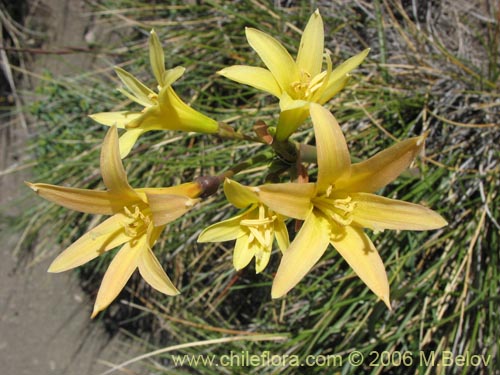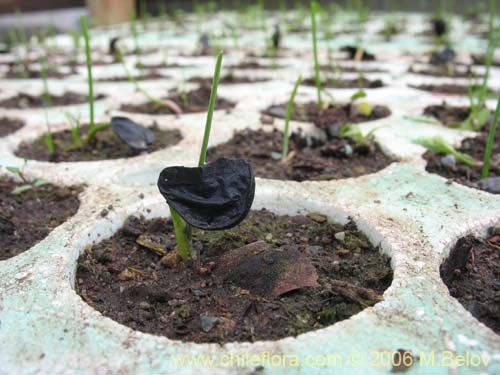|
|

Image of Rhodophiala montana
VII Region, Camino a Laguna Maule, Chile
Altitude: 500-2200 m. 01 13, 2006
|
|
| Species: | Rhodophiala montana (Phil.) Traub | |
| Family: | Amaryllidaceae | |
| Order: | Liliales | |
| Chilean Name: | Añañuca de las montañas | |
| English Name: | ||
| German Name: | ||
| Russian Name: | ||
| Record: | 0256 |
| About 26 Rhodophiala in Chile and 22 in our data base. | |
| About 38 Amaryllidaceae in Chile and 31 in our data base. |
  |
|
|
|
|
| Endemic Frequent
Height: 35 cm. Excellent ornamental value (A +) |
SILENCE KILLS...Civilized Human Beings can not be Silent Accomplices to Murder and War CrimesDid you know that: |
INTRODUCTIONThis is another Rhodophiala of the Central Andes of Chile - it has big flowers, somewhat smaller than of the other Rhodophialas, of almost pure yellow color. Although it is considered rare, in the few places where it grows, it can be found in largequantities. |
|
Image of Rhodophiala montana VII Region, Camino a Laguna Maule, Chile
|
DESCRIPTIONPlant type: Perennial Flower: Yellow, 6 petals Height: 35 cm.
This is a perennial bulbous plant of about 20 - 30 cm. The leaves are generally absent during the flourishing. The leaves are linear and 10 - 20 cm long and about 5 - 8 mm wide. The plant has yellow flowers with six yellow stamens and one yellowishpistil which is quite longer than the stamens. The flowers come in groups of 3 - 6. The seeds come in a three-parted greenish-brown capsule which contains about 20 - 40 shiny black flat round seeds of 1 cm of diameter stacked up one on the other like pages of a book. The flowers appear in November - January, and the seeds are ripe in February-March. This plant may hybridize with the Rhodophiala rhodolirion, because in places where they grow together the yellow color may take a pinkish, reddishor orange hue. |
|
Image of Rhodophiala montana VII Region, Chileflora Lab., Chile
|
HABITATIn Chile this species grows in the following environmental conditions:
Habitat according to altitude: High altitude close to the timber line
Watering conditions: Humid areas, with almost constant rainfall. Short dry periods are possible (generally not longer than 1 month).
Light conditions: Fully exposed to the sun. Level areas or slopes facing north.
This plant gows at high elevations in Central-southern Chile, in Talca at about 1600 - 2100 m., close to the tree line, prefers sunny spots, generally on sandy or rocky ground with good drainage; it grows preferably on soils with low organic content. It needs a lot of water during its vegetative growth (in early spring), but during the flowering it can withstand dry spells of up to two months (the bulbs store nutrients and water necessary for flowering). |
|
Image of Rhodophiala montana VII Region, Camino a Laguna Maule, Chile
|
USESExcellent ornamental value (A +)
Ornamental. There are oral reports (not confirmed) of local people indicating that its bulb may be edible. |
|
Image of Rhodophiala montana VII Region, Camino a Laguna Maule, Chile
|
GROWING TIPSThis species has the following hardiness: USDA Hardiness Zone 7, even 6b. The plant tolerates low temperatures (-15° C even -20° C), it can be covered by snow for months (1 - 8 months).
Very easy to cultivate
It can be easily propaged by seeds or by division of bulbs. The seeds must be immersed in water for a day o two and then planted at about 18ºC. The stratification at cold temperatures seems to be not necessary for this variety. Do not expect flowers for at least two seasons, because the bulb needs time to develop. If you are interested in purchasing seeds of this or similar species, please go to our On-line Seeds Shop. |
|
More photos (7) of Rhodophiala montana (Phil.) Traub available here |
|
More species from the same Amaryllidaceae family in our data base: Narcissus tazeta (Junco / narciso) Narcissus tazetta subsp. italicus (Junco / narciso) Phycella bicolor (Azucena del diablo) Phycella ignea (Añañuca de fuego) Rhodophiala andicola (Añañuca de los volcanes) Rhodophiala bagnoldii (Añañuca amarilla) Rhodophiala laeta (Añañuca rosada) Rhodophiala montana (Añañuca de las montañas) Rhodophiala phycelloides (Revienta ojos) |




